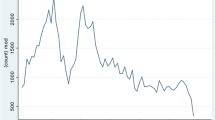Abstract
The decision to foreclose on a CMBS mortgage is made by the special servicer. A mortgage loan is in special servicing when it is either delinquent or in a state of imminent default. A special servicer should represent the interests of the underlying CMBS bondholders by returning the highest possible value to the investors. In this paper, we show that a special servicer’s compensation structure results in an incentive for her to extend a loan beyond the time desired by its bondholders. We develop a model and demonstrate how compensation incentives interact and influence a special servicer’s foreclosure decisions. Our model takes into consideration the dynamic nature of such a decision by viewing is as a dynamic programming problem whereby foreclosure represents a discrete terminal state of an optimal stopping problem. This model thus captures the trade-off between continuation of a loan and termination and we use this model to determine how the stopping rule changes under various compensation structures.








Similar content being viewed by others
Notes
We later relax this assumption by assuming the holdings of the first-loss pieces decrease over time.
Normally the coupon rate of a subordination bond is higher than that of the senior tranche. However, making the interest rates of the two tranches the same does not affect the main result.
The error term can be interpreted as special servicer’s heterogeneity. For example, if a special servicer chooses to hedge her first-loss holdings by entering into swap contracts, her workout strategy will be different from that of those who have market exposure to first-bond price risks. For discussion of different interpretation and model techniques of the error terms, please see Rust (1992).
Under current special servicing industry practice, the workout fee is the same as the amount of fees received if a special servicer forecloses on a loan.
Note Eq. 6 does not have an error term, because it is one of the possible results from a decision to continue. Modeling all possible loan modifications is not tractable.
We choose the initial NOI0 level to normalize foreclosure bias rather than NOI ∗ , because NOI itself is a random variable and it can vary dramatically according to state realizations, which makes the normalized bias unstable.
The severity of special servicing can be measured in terms of the number of months under special servicing by assuming that the incremental advance equals the total monthly debt payment.
This may be due to changes in people’s perception of risk or valuation of risks.
Some of the recommendations are consistent with the recent CMBS deal—the $788.5 million GS Mortgage Securities Trust 2010-C1, backed by commercial mortgages contributed by Goldman Sachs, Citi and Starwood Property Trust. In this deal, where Wells Fargo was appointed master and special servicer, a cap was put on special servicer fees for loan workout. The replacement of the special servicer will be determined by the a majority vote; no single bond class will have the right to replace the special servicer. In addition, the deal eliminated the traditional option for the special servicer to buy defaulted loans. Instead, loans have to be marketed and sold to the highest bidders.
References
Ambrose, B., & Sanders, A. (2003). Commercial mortgage default and prepayment analysis. Journal of Real Estate Finance and Economics, 26(2), 179–196.
Ambrose, B., Yavas, A., & Sanders, A. (2010). CMBS special servicers and adverse selection in commercial mortgage markets: Theory and evidence. Working paper.
Brown, D. T., Ciochetti, B. A., & Riddiough, T. J. (2006). Theory and evidence on the resolution of financial distress. Review of Financial Studies, 19(4), 1357–1397.
Ciochetti, B., Gao, B., Deng, Y., & Yao, R. (2002). The termination of lending relationships through prepayment and default in the commercial mortgage markets: A proportional hazard approach with competing risks. Real Estate Economics, 30(4), 595–633.
Chen, J., & Deng, Y. (2010). Commercial mortgage workout strategy and conditional default probability: Evidence from special serviced CMBS loans. NUS Working paper.
Commercial Mortgage Alert (2009, 2010). Research reports from various issues of Commercial Mortgage Alert. Harrison Scott Publication Inc.
Gan, Y. H., & Meyer, C. (2007). Agency conflicts, asset securitization, and securitization. NBER working paper.
Lebret, D. & Quan, D. (2008). Structural model of credit for commercial real estate in presence of delinquency and liquidation. Cornell University Working paper.
Rust, J. (1987). Optimal replacement of GMC bus engines: An empirical model of Harold Zurcher. Econometrica, 55, 999–1033.
Rust, J. (1992). Estimation of dynamic structural models: Problems and prospects, part I. Working Paper.
Vandell, K. D., Barnes, W., Hartzell, D., Kraft, D., & Wendt, W. (1993). Commericial mortgage defaults: Proportional hazards estimation using individual loan histories. Journal of American Real Estate and Urban Economics Association, 21(4), 451–480.
Acknowledgements
The authors acknowledge valuable discussions with Yongheng Deng, Piet Eichholtz, David Geltner, Patric Hendershott, James Shilling, Alan Todd, Tricia Hall, and participants at the 2010 American Real Estate and Urban Economic Association annual meeting at Atlanta, the International Real Estate Economics and Finance Research Seminar at Skye, Scotland, and the 2010 MNM Symposium at MIT.
Author information
Authors and Affiliations
Corresponding author
Rights and permissions
About this article
Cite this article
Liu, P., Quan, D. Foreclosure of Securitized Commercial Mortgages—A Model of the Special Servicer. J Real Estate Finan Econ 46, 321–338 (2013). https://doi.org/10.1007/s11146-011-9337-9
Published:
Issue Date:
DOI: https://doi.org/10.1007/s11146-011-9337-9




